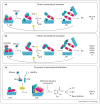A new eye on NLR proteins: focused on clarity or diffused by complexity?
- PMID: 22305607
- PMCID: PMC3482489
- DOI: 10.1016/j.coi.2011.12.006
A new eye on NLR proteins: focused on clarity or diffused by complexity?
Abstract
The nucleotide-binding domain leucine-rich repeat proteins (NLRs) represent the major class of intracellular innate immune receptors in plants and animals. Understanding their functions is a major challenge in immunology. This review highlights recent efforts toward elucidating NLR functions in human and plants. We compare unconventional aspects of NLR proteins across the two kingdoms. We review recent advances describing P-loop independent activation, nuclear-cytoplasmic trafficking, oligomerization and multimerization requirements for signaling, and for expanded functions beyond pathogen recognition by several NLR proteins.
Copyright © 2012 Elsevier Ltd. All rights reserved.
Figures



Similar articles
-
NLR, the nucleotide-binding domain leucine-rich repeat containing gene family.Curr Opin Immunol. 2008 Feb;20(1):3-9. doi: 10.1016/j.coi.2008.01.003. Epub 2008 Feb 15. Curr Opin Immunol. 2008. PMID: 18280719 Review.
-
NOD-like receptor cooperativity in effector-triggered immunity.Trends Immunol. 2014 Nov;35(11):562-70. doi: 10.1016/j.it.2014.09.005. Epub 2014 Oct 9. Trends Immunol. 2014. PMID: 25308923 Review.
-
Signal transduction pathways used by NLR-type innate immune receptors.Mol Biosyst. 2008 May;4(5):380-6. doi: 10.1039/b718948f. Epub 2008 Mar 27. Mol Biosyst. 2008. PMID: 18414735 Review.
-
The microbial and danger signals that activate Nod-like receptors.Cytokine. 2008 Sep;43(3):368-73. doi: 10.1016/j.cyto.2008.07.013. Epub 2008 Aug 19. Cytokine. 2008. PMID: 18715799 Review.
-
The HSP90-SGT1 chaperone complex for NLR immune sensors.Annu Rev Plant Biol. 2009;60:139-64. doi: 10.1146/annurev.arplant.59.032607.092906. Annu Rev Plant Biol. 2009. PMID: 19014346 Review.
Cited by
-
Multiple Evolutionary Events Involved in Maintaining Homologs of Resistance to Powdery Mildew 8 in Brassica napus.Front Plant Sci. 2016 Jul 21;7:1065. doi: 10.3389/fpls.2016.01065. eCollection 2016. Front Plant Sci. 2016. PMID: 27493652 Free PMC article.
-
Advances in Biological Control and Resistance Genes of Brassicaceae Clubroot Disease-The Study Case of China.Int J Mol Sci. 2023 Jan 2;24(1):785. doi: 10.3390/ijms24010785. Int J Mol Sci. 2023. PMID: 36614228 Free PMC article. Review.
-
Genome-Wide Identification, Characterization, and Comparative Analysis of NLR Resistance Genes in Coffea spp.Front Plant Sci. 2022 Jul 7;13:868581. doi: 10.3389/fpls.2022.868581. eCollection 2022. Front Plant Sci. 2022. PMID: 35874027 Free PMC article.
-
Identification of mildew resistance in wild and cultivated Central Asian grape germplasm.BMC Plant Biol. 2013 Oct 4;13:149. doi: 10.1186/1471-2229-13-149. BMC Plant Biol. 2013. PMID: 24093598 Free PMC article.
-
The nuclear immune receptor RPS4 is required for RRS1SLH1-dependent constitutive defense activation in Arabidopsis thaliana.PLoS Genet. 2014 Oct 23;10(10):e1004655. doi: 10.1371/journal.pgen.1004655. eCollection 2014 Oct. PLoS Genet. 2014. PMID: 25340333 Free PMC article.
References
-
- Jones JD, Dangl JL. The plant immune system. Nature. 2006;444:323–329. - PubMed
-
- Segonzac C, Zipfel C. Activation of plant pattern-recognition receptors by bacteria. Curr Opin Microbiol. 2011;14:54–61. - PubMed
-
- Guo YL, Fitz J, Schneeberger K, Ossowski S, Cao J, Weigel D. Genome-wide comparison of NB-LRR encoding genes in Arabidopsis. Plant Physiol. 2011;157:757–769. The authors compared the repertoire of NLR proteins of Arabidopsis thaliana with its outcrossing relative A. lyrata and analyzed inter-specific and intra-specific diversity. - PMC - PubMed
Publication types
MeSH terms
Substances
Grants and funding
LinkOut - more resources
Full Text Sources

